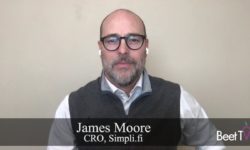INDIANAPOLIS – Connected TV advertising promises super targeting, frequency capping and attributing outcomes back to view exposures.
But, lately, that sales pitch has been searching for a buyer.
In this video interview with Beet.TV, Ira Maher, VP, Media Insights & Technology at The Basement, an advertising agency, says buyers have struggled to find quality inventory, especially in a political cycle.
Election effect
“It’s been a little tight as we get through some of the political windows, depending on the market that we’re focusing on,” Maher says.
For a period of time, the reason that we were holding back on CTV, as a core to our recommendations, was because we didn’t love the quality of the inventory, especially the places where frequency was such an issue, and there were pretty significant concerns around fraud.
“From engaging directly with the providers in this space … that’s translating into a pretty sizeable year-on-year increase in their willingness to buy CTV, OTT types of inventory.”
Many campaigns in November’s US elections turned to connected TV advertising both because of precision targeting and as big-spending campaigns bought heavily in traditional linear, locking up the airwaves.
Fixing fragmentation
OTT streaming services accounted for 25% of all US TV-viewing minutes during Q2 2020, according to Nielsen’s Streaming Meter.
EMarketer estimates CTV ad spending will reach $10.81 billion in the US in 2021 – up 56% from two years earlier, and representing around 15% of total US TV ad spending.
But the medium also suffers from fragmentation – buying opportunities, like content, are strewn across a plethora of devices and OTT services.
Maher says The Basement has been trying to find its way through the maze.
“The fragmentation of the market, obviously, has a pretty significant impact, and for us, there’s been a level of education responsible to help a client understand some of the trade-offs and complexities,” he says.
“So our focus has been, let’s find the means through which to transact, and the inventory that gives us the best balance between the appropriate measurability and scale of audience.”
What works
Maher’s agency buys through platforms including Simpli.fi’s. So, what works? Maher says The Basement has found good outcomes from precise audience targeting, local audience targeting and outcome attribution:
- Audience targeting: “We’ve seen some really, really great successes when we’re heavily confident that we have our audience targeting. We were able to get to our audience and target them effectively with a clear message, and then we have a KPI that our client is comfortable, has a marked impact on the business outcome that they desire.”
- Outcome attribution: “Where we’ve been able to set up metrics to specifically tie ad exposure to some sort of online action, and, ultimately, in a couple of cases, actually to cart and conversion, those have been tremendous successes.”
- Local targeting: “We’ve shied away from explicitly deploying broad national targeting, because, in a lot of cases, we’re just not entirely confident that we’re going to get the desired outcomes. So we’ve really been focusing in as precise areas as we possibly can, so that we’re confident that we’re able to deliver results”
And he says he prefers to do direct ad buy deals with publishers, versus programmatically-enabled buys.
You are watching “Streaming Boom Accelerates the Adoption of CTV,” a Beet.TV leadership series presented by Simpli.fi. Please visit this page for more videos.

































